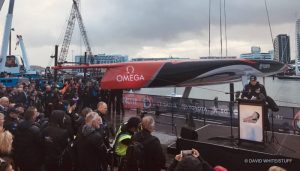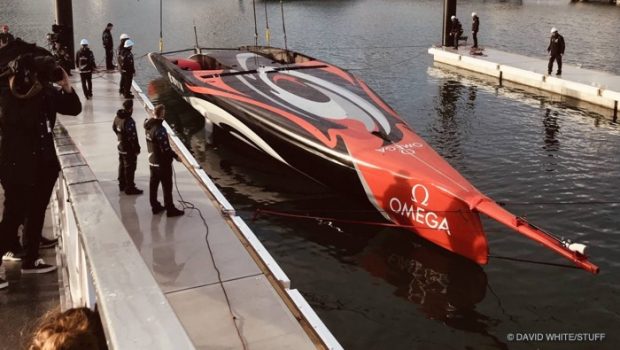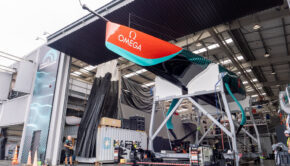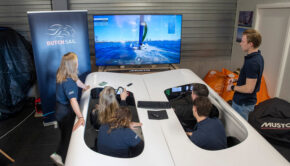Team New Zealand First to Launch
Published on September 5th, 2019
A large gathering of sponsors, suppliers, team members and their families, politicians, including Prime Minister Jacinda Ardern, along with the general public attended the ceremony outside the Emirates Team New Zealand base. Team New Zealand christened their new America’s Cup yacht “Te Aihe”, Maori for dolphin, at the official launch in Auckland on September 6.
The name Te Aihe (Dolphin) is based on the whakatauki (proverb):“Mā te Aihe e tuitui ai i te ngaru moana, mā te Rangatira e tuitui ai i te tangata”. “As the dolphin sows through the seas so does a leader sew people together”.
It was the first AC75 launched by any of the five teams that will be involved at Auckland 2021. Challengers Luna Rossa of Italy, INEOS Team UK, American Magic and Stars + Stripes Team USA will sail against each other with the winner going on to race Team New Zealand for the Auld Mug.
The boat was christened at 7.35am on September 6, 2019, local time in Auckand, by Marcus Gerbich, a member of the Motor Neuron Disease Association, which is the team’s official charity. The sleek 75-foot boat, painted black, red, grey and white, was blessed by Ngati Whatua who have a long association with the yachting syndicate.
The revolutionary design was suspended on a crane outside the base and splashed in the water after the traditional champagne moment. It didn’t feature its huge mast.

Ironically, just as much of it was on show yesterday when it sat in a cradle on the base’s forecourt, having its mast maneuvered into position by a large crane. Its hull and foil arms were clearly on display with shrouding not allowed under the rules that govern this 36th edition of the America’s Cup.
It is estimated the state-of-the-art boat took more than 100,000 man hours to design and build with around 65 people involved in that process. For the first time Team New Zealand have fully built their own boat at a purpose-built facility on Auckland’s North Shore.
TNZ chief executive Grant Dalton said it was a nervy time for him during the launch with the boat hoisted in the air. “It is a special morning for us, it’s been a long time coming. It’s emotionally stressful watching a boat up in the air at a launch like this. It rained, which I’m told is good luck. It’s been low key, which is the way we wanted it.”
Team New Zealand ace Peter Burling can’t wait to go from the virtual world to reality after months spent on a state-of-the-art simulator. That experience is about to be replaced by the real thing, with the revolutionary 75-foot foiling monohull launch and sailing at the first weather-appropriate opportunity.
Much of the initial work will be about calibrating the real boat against what was revealed on the simulator and understanding how to fully power and maximize a yacht that has never been seen before, let alone sailed. This is racing on a whole new scale.
“It’s going to be incredible to get it out and start debugging it,” Burling said of a boat he has had plenty of input into through the design and build process. “We have a massive list of things to check off. We’ve been looking at it getting built for the last little while now and it’s incredible to see it all coming together. It’s going to be a pretty cool spectacle for everyone to see. It just pushes the sport that much further and the performance that much further.”
Burling backs the decision by Emirates Team New Zealand to stick to the simulator process against the small-scale test boat program adopted by their major rivals American Magic, INEOS Team UK and Luna Rossa. He added, “Everyone makes their decisions for a reason and we are really happy with the pathway we have gone down. You have to make a call as to how you make up your campaign.
“With the simulator, it definitely has its strong points. We can’t say too much about it. There has definitely been plenty of work going on behind closed doors, plenty of designers, plenty of boat builders, a lot of really smart people collaborating. Now we are looking forward to getting it out on the water.”
Burling, in his second Cup cycle, predicts a real battle at Auckland 2021 with a small but highly financed and competitive challenger fleet vying to take on the defender. “We don’t have a massive amount of challengers but the challengers we do have are all incredibly strong and all sailing very similar programs,” he said.
Emirates Team New Zealand COO Kevin Shoebridge, who has overseen the development and launch of plenty of boats over the years, was especially proud to be witnessing the Kiwi AC75 emerge for the first time.
“This is a significant occasion for the team, not just because it is another new boat, but really because when we won the America’s Cup in 2017 we very quickly had to come up with a new concept of boat that would really continue to push the boundaries of innovation and technology in the America’s Cup.
“So in the relatively short timeframe since November in 2017 when we published the concept, to seeing it in the flesh today is an amazing testament to the entire team willing to push things all the way from concept to design to build and fit out” said Shoebridge.
It has taken over 100,000 man-hours to design and build the boat with a group of about 65 people between designers and boat builders who have been working quietly throughout the past year. Sean Regan has led the set up of the team’s bespoke production facility on Auckland’s North Shore from a blank factory floor to producing the first AC75.
“We have had the pressure on since the moment we decided to establish our own production facility very early on in this campaign. We have built up a really great team of 42 fully committed people at the yard who have been working full-on to get this boat out the door,” said Regan.
“Even for the most experienced boat builders on the team, this has been a very unique build because it is such a sophisticated boat. But it is really encouraging that for a number of our junior and apprentice boat builders their first build has been on a boat that is really on the cutting edge of complexity in build, design and performance.”
Emirates Team New Zealand Head of Design Dan Bernasconi was a central figure in the development of the AC75 Class Rule before turning his team of designers’ attention to the specific design of the Emirates Team New Zealand boat.
“There’s a huge amount of innovation in the design and build of the AC75 – more than we saw in the AC50’s in Bermuda” said Bernasconi. “The AC75 is a completely new concept and has presented plenty of challenges across many areas, but this is precisely what the Rule was designed to do, to push development to the extreme.
“We haven’t been conservative in any aspect of our design; it’s not long until we need to commit to the design of our second boat, which we will ultimately race in the 2021 America’s Cup, so we need to test as many of our ideas as possible in the yacht we’re launching today.”
Unlike the other main Challengers, Emirates Team New Zealand has focused the development of their first boat entirely with their in-house simulator as opposed to building a smaller scale test boat to validate concepts on the water. So once the AC75 goes for its maiden sail, it will be the first time the team has collectively sailed since winning the America’s Cup on June 26th 2017.
“It won’t be without nerves the first time we go sailing, but I am sure that is no different for all of the teams,” said Glenn Ashby, “The AC75’s are big powerful and fast boats so they will be a handful, but from our understanding through our simulations they are inherently a safer boat to sail than what we have sailed in the past two America’s Cups.
As with any new boat it is all about slowly getting it up to speed, learning how to sail it most efficiently, pushing the development of the designs and then putting in the hours in getting ready to race for the ACWS Sardinia in April 2020.”
Emirates Team New Zealand will now focus on a busy period of testing on Auckland’s Hauraki Gulf over the spring and summer months having the advantage of developing and training on the race area of the America’s Cup Match which will be raced in March 2021.
The AC75 Class is a 75 foot, high performance monohull governed by the AC75 Class Rule which was published on 29 March 2018. The Class Rule is open enough to guarantee a wide margin of freedom to the designers but introduces certain one-design elements for cost containment also.
The AC75 supplied parts – identical for all the teams – are the foil arms, the foil cant system and the rigging. The shape and base laminate of the mast is also controlled by the Class Rule.
The AC75 rotating mast is a 26.5 meter long one-design ‘D’ shaped section that weighs about 300kg and serves as the leading edge of the double skinned mainsail. Emirates Team New Zealand’s mast has been built at Southern Spars in Auckland whereas the rigging package was built at Future Fibres in Valencia.
The two other one-design components are key to make the boat fly. The foil arms, built at Persico Marine in Italy, are the result of a project led by Luna Rossa Challenge with the collaboration of all the America’s Cup teams and New Zealand based composite engineering consultancy Pure Design and Engineering. Each 4.5 metre long carbon foil arm has a wing attached to its tip. The foil wings are custom designed and built by each team.
Driving the foil arms is the electronic and hydraulic foil cant system (FCS), another one design supplied part, which moves the arms and wings in and out of the water. The foil cant system was designed by Emirates Team New Zealand and assembled in Auckland before being distributed to all teams earlier in the year.
The rest of the Class Rule is open and being a new concept, leaves the design quite open as no proven path has yet been defined for these types of boats. Any shrouding of the yachts in the 36th America’s Cup is prohibited so teams won’t be able to hide their different design approaches and subsequent developments.
The most visible differences will be seen in the hull shapes and deck layouts. Despite a number of basic constraints such as the length, the hull shape has few significant limits on shape or structure. Design teams will be looking for a shape with minimal drag in light-wind displacement mode while also addressing the stability required to generate thrust for take off.
Evident differences will be displayed also in the foil wings and wing flaps as they are also open to design and, being T-style foils, their shapes have been less explored than the L- foils used in the last two Cups.
The double-surface mainsail, a new innovation of the 36th America’s Cup Class Rule, will be key in the performance of the boat and a lot of hours have been invested in its design.
The hydraulic and electronic control systems, powered and controlled by the crew, operate key components of the boat such as the foils and they have been subjected to important developments as well but will they remain a vey guarded secret by each team.
Luna Rossa will launch their boat early next week while the American syndicates Stars and Stripes and American Magic and Britain’s Team UK will soon follow.
Teams are allowed to build two boats and Team New Zealand are already turning their attention to the design of their second AC75 which is expected to feature subtle changes and significant performance gains for the America’s Cup defense.
America’s Cup AC75 in numbers:
Hull length: 20.7m plus 2m bowsprit
Maximum beam: 5m
Weight: 6.5T
Mast height: 26.5m from deck
Sails: 135-145sqm mainsail, 90sqm jib, 200sqm code zero
Rudder: Centreline T foil, 3.5m maximum draft, 3m maximum span
Foils: Twin-canting T foils, 5m maximum draft, 4m wing span
Crew: 11 sailors (960-990kg combined weight)
In addition to Challenges from Italy, USA, and Great Britain that were accepted during the initial entry period (January 1 to June 30, 2018), eight additional Notices of Challenge were received by the late entry deadline on November 30, 2018. Of those eight submittals, entries from Malta, USA, and the Netherlands were also accepted. Here’s the list:
Defender:
• Emirates Team New Zealand (NZL)
Challengers:
• Luna Rossa (ITA) – Challenger of Record
• American Magic (USA)
• INEOS Team UK (GBR)
• Malta Altus Challenge (MLT) – WITHDRAW
• Stars & Stripes Team USA (USA)
• DutchSail (NED) – WITHDRAW
Of the three late entries, only Stars+Stripes USA remains committed, but they still must complete the entry fee payment process before they will be eligible to race. They have already paid their initial payment but as a late entry challenger under the Protocol they also have a liability to pay a US$1million late entry fee due in installments by October 1, 2019. This deadline coincides with the venue schedule which has the construction of their team base beginning in late 2019, which we assume was done in the event the team is unable to fulfill their payment deadline.
Key America’s Cup dates:
✔ September 28, 2017: 36th America’s Cup Protocol released
✔ November 30, 2017: AC75 Class concepts released to key stakeholders
✔ January 1, 2018: Entries for Challengers open
✔ March 31, 2018: AC75 Class Rule published
✔ June 30, 2018: Entries for Challengers close
✔ August 31, 2018: Location of the America’s Cup Match and The PRADA Cup confirmed
✔ August 31, 2018: Specific race course area confirmed
✔ November 30, 2018: Late entries deadline
✔ March 31, 2019: Boat 1 can be launched (DELAYED)
✔ 2nd half of 2019: 2 x America’s Cup World Series events (CANCELLED)
October 1, 2019: US$1million late entry fee deadline
February 1, 2020: Boat 2 can be launched
April 23-26, 2020: First America’s Cup World Series event in Cagliari, Sardinia.
During 2020: 3 x America’s Cup World Series events
December 10-20, 2020: America’s Cup Christmas Race
January and February 2021: The PRADA Cup Challenger Selection Series
March 2021: The America’s Cup Match
Details: www.americascup.com









 We’ll keep your information safe.
We’ll keep your information safe.